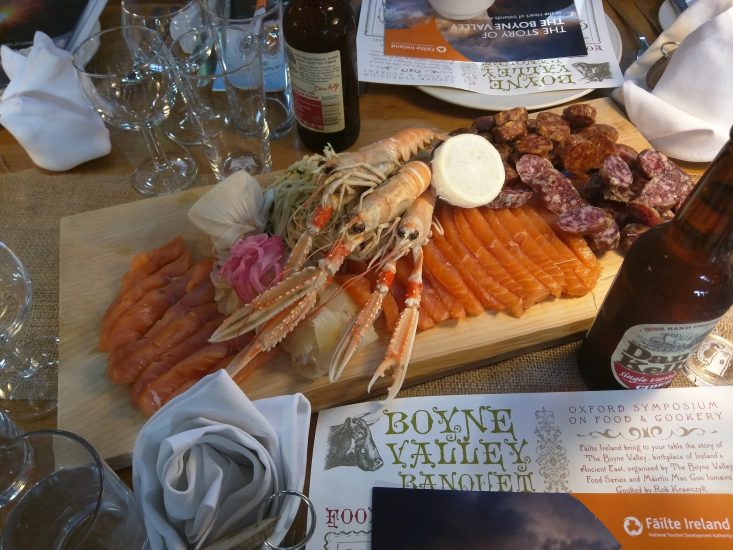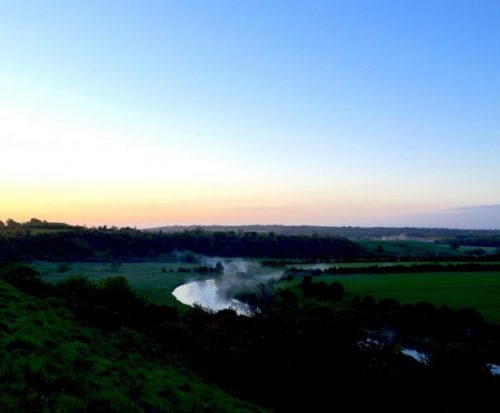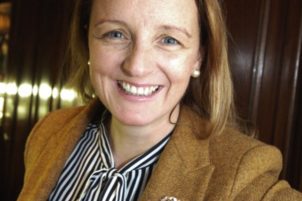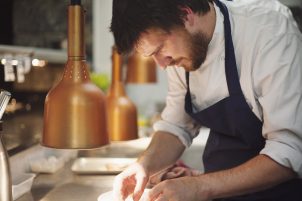
Spotlight on a Meal: Boyne Valley Banquet

Máirtín Mac Con Iomaire introduces a banquet for the 2017 Symposium produced by the Boyne Valley Food Series, sponsored by Fáilte Ireland
What was the inspiration for this meal?
This meal is centered around the landscape and mythology of the Boyne Valley in northeast Ireland. When the Irish goddess Boann upset the Well of Inspiration, it boiled over in outrage. The river was born and took its name—Boyne—from her.
The Boyne Valley has an ancient history, home to the Hill of Tara, seat of the High Kings of Ireland, and to the UNESCO world heritage centre Newgrange or ‘Brú na Bóinne’, a megalithic passage tomb aligned with the rising sun of the winter’s solstice built over 5000 years ago, predating Stonehenge and the Pyramids at Giza.
With this meal we aim to bring the history and landscape of the Boyne Valley to life—from canapés or ‘blaisíní’ (little tasters) presented in soil, to mist rising over oysters, to a taste of milk and honey. The centrepiece of the banquet will be a tongue-to-tail celebration of beef—an Irish obsession. The Irish word for cow is ‘bó’, and pervades the Irish language: ‘bóthar’ means road, which were measured out by the length and breadth of a cow; ‘buachail’ means boy, derived from bua (cow) and chaill (attendant); and then there are the innumerable Irish place names—Ardboe, Drumbo, Lough Bo, Drumshambo, Inishbofin, and of course, the river Boyne, named after Boann, goddess of the white cow.
What is history behind some of the products you have chosen to serve?
The menu, put together by Rob Krawczyk, celebrates the region’s best produce new and old and the work of its many artisanal food producers, such as mineral rich oysters from Carlingford Bay, Oriel sea salt, and renowned Lannléire honey that draws its unique flavour from the flora of this mythic landscape. We strive to present our beautiful produce as simply as we can so that guests can taste and appreciate the storied richness of the landscape, known as ‘the land of 5,000 dawns’.
Beef and salmon are two of the oldest ingredients associated with the region, and are highlights of the menu. Cattle have been central to the Irish way of life for centuries, feeding on the rich green grass that grows so abundantly in Ireland’s damp, temperate climate. Cattle were a measure of wealth in Gaelic Ireland, and feature prominently in Irish mythology and histories of the aristocratic class. Scientists have carbon-dated a cow bone found in an archaeological dig in County Kerry to 4500BCE, and indeed, one of the papers at this year’s symposium by Juliana Adelman discusses Ireland’s more recent historic role in providing beef to the English market. The beef for this dinner comes from the fine herd of Donegan.
Wild salmon also features strongly in Irish mythology. One tale describes how the River Boyne was home to a magical salmon that ate nuts from a hazel tree and was known as the Salmon of Knowledge. A druid had foretold that whoever first ate of the flesh of that magical salmon would have knowledge of all things. A young boy named Demne lost his warrior father before he was born. Fearing for her son’s safety at the hands of her husband’s killers, Demne’s mother sent him away to be raised by a woman warrior and druidess. Unable to avoid pursuit by his father’s enemies, Demne decided to become a poet, whose high status in Celtic society would shield him from harm. He studied with a poet named Finnéagas who lived near the River Boyne. Having watched the salmon for many years, Finnéagas finally caught it and told his apprentice Demne to cook the fish. While the salmon was cooking, Demne burnt his thumb. To ease the pain, he licked the burn thereby tasting the magical fish. Demne told Finnéagas what had happened, and his mentor decreed that the young Demne was the one intended to eat the salmon. Finnéagas changed Demne’s name to ‘Fionn’, meaning ‘fair’ or ‘white’, and Fionn received three gifts that would make him a great poet: magic, great insight, and the power of words. The salmon we will enjoy at the banquet includes both Harry Jordan’s turf-smoked salmon and Terry Butterly’s oak-smoked Coastguard Salmon.
The meal will also feature a selection of cheeses including Bellingham Blue, 15 Fields, and Boyne Valley Bán, combining the pasture-based dairy of the region’s landscape with the ancient Irish tradition of ‘Bán Bia’ or white meats. Each course has also been paired with artisanal beverages: Listoke 1775 gin and poachers tonic, Cockagee Perry or Stameen Apple Juice at the reception; Dan Kelly’s Single Varietal Cider for starters; Boyne Brewhouse Vienna Larger for Mains; Boyne Brewhouse Saison farmhouse-style Beer with the cheese; and a choice of Slane Irish Whiskey or Coole Swan Irish Cream Liqueur with dessert. As the Irish saying goes, ‘Is túisce deoch ná scéal’—a drink precedes the story!
Who is behind the Banquet, and what is The Boyne Valley Food Series?
The Boyne Valley Food Series is a group of chefs and restauranteurs, hoteliers, and producers who are passionate about celebrating food’s journey from landscape to table and its rich heritage in the northeast of Ireland. The Series, led by hotelier Olivia Duff, has brought together this Boyne Valley Banquet, in collaboration with chef Rob Krawczyk.
Olivia is the driving force behind the Boyne Valley Food Series. She is the hotelier at The Headfort Arms, in Kells, County Meath, and a producer of turkey, geese and lamb with her husband at Maperath Farm. She is a leader within the Irish food scene, traveling the country speaking about food tourism, sustainability and collaboration in small food businesses. A finalist in the Women in Agriculture Awards and recipient of the RAI Leinster Food Hero Award 2016, Olivia is one of Fáilte Ireland’s Food Champions.

Rob, our Banquet’s chef, was born in Cork and grew up in a home that revolved around the kitchen. His earliest source of inspiration was his father, Frank, who has been producing charcuterie for over twenty years in West Cork. Frank taught Rob the skills of curing and smoking meats, making salamis and dry aged coppa hams, while instilling a passion for fine food and the quality of the raw ingredient. Rob has worked for, among others, Richard Corrigan and Alice Waters. In 2015 and 2016 he won RAI Best Chef in Leinster 2015 and 2016.

The banquet team also includes Helen Byrne (Tankardstown House), Sally-Anne Cooney (Boann Distillery), Ryan McGivern (DIT Culinary Arts Graduate), Mary Farrell (Executive chef and PhD Candidate), and Dearbhla Moriarty (DIT Culinary Arts student). The banquet has been sponsored by Fáilte Ireland, the National Tourism Development Authority, whose role is to promote Ireland as a food tourism destination.
This year there will be three Fáilte Ireland Food Champions attending the Oxford Symposium, so do seek them out if you wish to learn more about this exceptional region for Irish gastronomy!
What is the connection with the Oxford Symposium on Food and Cookery?
There has long been an Irish connection with the Oxford Symposium from Myrtle Allen, Darina Allen, Regina Sexton, Elizabeth Field and Marilyn Bright to current trustee Máirtin Mac Con Iomaire and more recent attendees such as Dorothy Cashman, Tara Kellaghan, Elaine Mahon, Diarmuid Murphy, Diarmuid Cawley, JJ Healy, Samantha Martin McAulliffe and Keelin Tobin.
